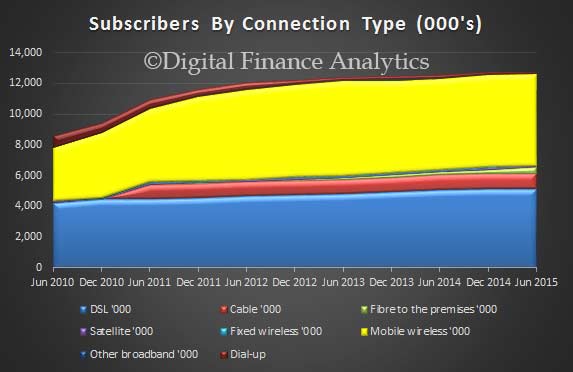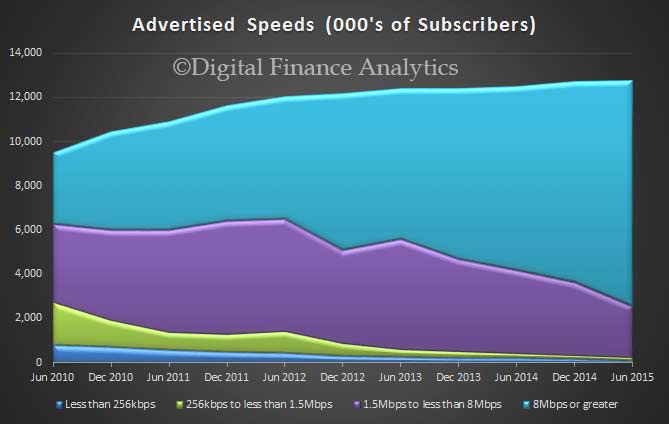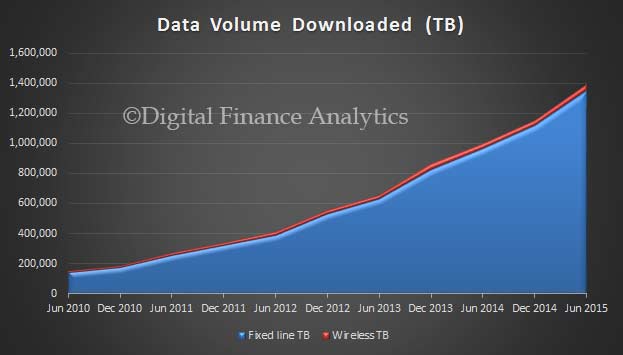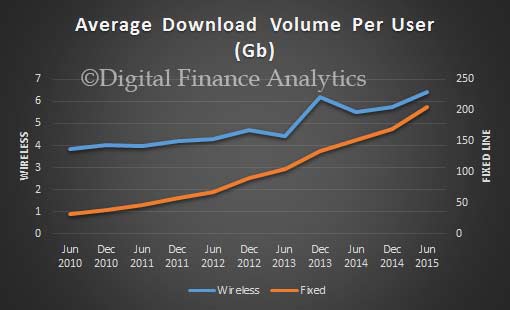The latest internet usage statistics from the ABS, released today, to June 2015 shows there were approximately 12.8 million internet subscribers in Australia at the end of June 2015. This is an increase of 2% from the end of June 2014. Our own surveys show that many households enjoy multiple internet connections, including a fixed line ADSL service, and mobile services, so subscriptions should not be equated with individual households (there are about 9 million separate households). This again highlights the digital disruption underway, which creates both opportunity and risk. The trends in our Quite Revolution Report on digital channels, if anything, understated the speed of change.
As at 30 June 2015, almost all (99%) internet connections were broadband. Fibre continues to be the fastest growing type of internet connection in both percentage terms and subscriber numbers. Internet subscriptions to a fibre connection increased by 107% (or 217,000 subscribers) from the end of June 2014 to the end of June 2015.
There are more mobile subscriptions than fixed subscriptions now, with 47% of subscriptions being for mobile services and 40% on ADSL services.
 The average speeds are increasing significantly, with more than 80% of subscribers now enjoying download rates of 8 Mbps more higher.
The average speeds are increasing significantly, with more than 80% of subscribers now enjoying download rates of 8 Mbps more higher.
 The volume of data being downloaded has risen significantly, especially via fixed line networks. Total volumes have more than doubled since 2012.
The volume of data being downloaded has risen significantly, especially via fixed line networks. Total volumes have more than doubled since 2012.
 The average user on a mobile subscription downloads about 6 Gb of data, up from 4 Gb in 2010 per month. However the real growth has been in fixed line services, where the average user is now close to 200 Gb a month, compared with 45 Gb in 2010.
The average user on a mobile subscription downloads about 6 Gb of data, up from 4 Gb in 2010 per month. However the real growth has been in fixed line services, where the average user is now close to 200 Gb a month, compared with 45 Gb in 2010.
 The data volumes are likely to continue to grow, thanks to video on demand services, and more content rich sources, as well as cloud services. The nbn may not delivery sufficient capacity soon enough, and we are slipped behind other countries in terms of capacity and speed. Innovation and growth will likely be slowed as a result.
The data volumes are likely to continue to grow, thanks to video on demand services, and more content rich sources, as well as cloud services. The nbn may not delivery sufficient capacity soon enough, and we are slipped behind other countries in terms of capacity and speed. Innovation and growth will likely be slowed as a result.
